Dear Friend of the Lower Raritan Watershed –
In 2016 you and your neighbors joined the LRWP for:
16 clean-ups of area streams
1 pollinator garden installation
1 rain garden installation
3 water quality monitoring trainings (visual habitat, pathogens and macroinvertebrate identification)
3 multi-week K-12 environmental education programs
9 stakeholder meetings
7 special events (dance performances, gallery openings, field trips and special lectures)
10 community meetings, environmental festivals or other outreach events
2 blessings of area streams
You also: adopted 20+ stream segments for habitat monitoring, took soil and water samples, spearheaded 30+ research/internship projects, volunteered to help shape the LRWP’s strategic and business plans, developed maps, gave presentations, created 20+ sculptures out of trash, provided counsel and advice, and so much more. For your time and commitment to a healthier Lower Raritan Watershed, we say a very sincere THANK YOU!
Now we come to you, humbly, to ask for more. We cannot advance our collective work on the path to a healthier Raritan River and Lower Raritan Watershed without your financial support. So please consider the Lower Raritan Watershed Partnership in your charitable giving.
CLICK HERE TO DONATE
We know there are many good charities that will seek your help. We are truly honored when you choose to make a tax-deductible gift to the Lower Raritan Watershed Partnership.
With all the best to you and your family for a wonderful holiday season and a happy, healthy 2017.
Heather Fenyk
President and Founder
Lower Raritan Watershed Partnership
Except as noted, article and photos by Joe Mish
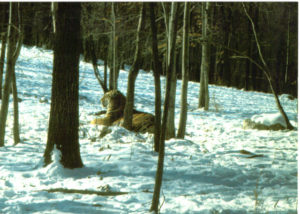
A Siberian tiger, out of place in modern times in New Jersey, comfortably rests on the frozen snow in sub zero temperatures, intensified by a strong northwest wind. Conditions that would turn exposed flesh beet red in an instant, didn’t phase this big cat as it appeared oblivious to the deadly weather; as if not bound by the laws of Nature.
It was a bitter cold day as Bert and I drove the Warner Bros Jungle Habitat trails to check on the open ranging wildlife that occupied the windswept mountains and valleys of the northern New Jersey wildlife park. Inside the warm Chevrolet truck, converted into a veterinary mobile unit, the heater was turned up high, while warm coffee steamed the windshield. Most animals escaped the polar wind hiding behind natural windbreaks and temporary shelters placed around the park.
As we drove past the tiger compound, near the highest point of the park, here was this tiger, a cat we affectionately named, ‘Bobtail’, lying down exposed to the full force of the wind. Bearing an ever present grin, for which the big cats are known, Bobtail appeared content, oblivious to the deadly arctic blast. He remained motionless and stared into the brutal wind that must have escaped from the 10th circle of Dante’s frozen hell, showing no signs of discomfort. He may as well have been enjoying a cool breeze on a warm summer’s day.
This image of Bobtail lying in the snow captures for me the essence of the tiger. Well documented accounts of tigers hunting humans in India, and their magical ability to make kill after kill and avoid inescapable traps, have elevated the tiger to supernatural status.
This is an animal believed to exist in the spirit world as a cunning killer with the ability to transform into flesh and bone and back again at will. The tiger has a reputation of defying natural law that limits all other living things; Bobtail was doing nothing to dispel that myth on this cold day.
The poem, “Tyger”, by William Blake, written in 1794, so well captures the visceral reaction I had to the tigers, I memorized the poem. Here are a few lines that chill my blood.
In what distant deeps or skies Burnt the fire of thine eyes?
And what shoulder, & what art. Could twist the sinews of thy heart?
While here is photographic proof of a tiger living in New Jersey, an anomaly for sure, it is not hard to imagine a time when big cats stalked our land. I wondered every time I passed the tiger compound, how humans ever survived these Paleolithic predators. Perhaps it was the predators’ evolved intelligence that raised the level of human creativity in a Darwinian dance played to a deadly tune.
Evidence of saber tooth cats and jaguars, among other prehistoric creatures, were found in a limestone cave in southeastern PA near Pottstown and trace back to the cretaceous period about 100 to 66 million years ago. The cave was located in a now forgotten town named Port Kennedy, which is part of Valley Forge National Park.
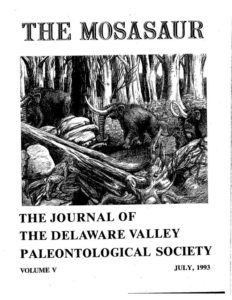
Evidence of sabre-tooth cats of the late cretaceous period discussed in this 1993 article. Additionally fossil remains have been found in the Cutter Clay works near Raritan Bay and along the shore across Raritan Bay in Union Beach.
NJ was unrecognizable in terms of geography and climate with glaciers terminating at the Watchung Mountains and our rivers not yet formed. The Hudson River at one time was thought to have emptied into the lower Raritan watershed at Bound Brook.
As the sea level rose and fell over the eons, it formed clay banks along the Raritan and its bay where dinosaur fossils and tracks have been found. To date, I am not aware of any prehistoric cat trackways or fossils being discovered in NJ. Though surely, when southern NJ was above water, it would be reasonable to expect prehistoric cats, whose remains were found in the Port Kennedy Cave, to have roamed our land.
In more modern times the eastern mountain lion did stalk the shores of the Raritan and in fact a bounty was offered and the last local cat killed in the Sourland Mountains in the early 19th century. Officially, the last New Jersey mountain lions were killed in the southern most counties about that same time.
Rumors of mountain lions persist in several north east states, though no hard evidence has been uncovered in NJ. Given the fact that people have been known to illegally harbor large cats in less than secure enclosures, anything is possible.
Today, New Jersey has a healthy population of bobcats, primarily in the northwest part of the state. The retreating glaciers left a boulder strewn, mountainous landscape with plenty of nooks and crannies, ideal habitat for these elusive felines. Occasionally bobcats are captured on hunters’ trail cameras to give us evidence of their presence as they are rarely ever seen even where they are plentiful.
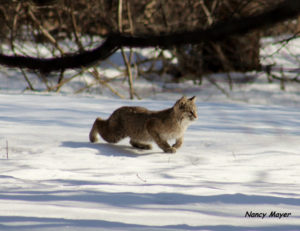
This very rare photo of a bobcat was taken in Warren County, NJ. New Jersey has a healthy bobcat population along with other wildlife thought not to exist within our borders. This cat is really a sabre-tooth tiger distilled down to miniature with all the accumulated intelligence and instincts required for survival in any geologic iteration of New Jersey. Photo by Nancy Mayer
Still the thought of saber-tooth cats, tigers and jaguars ranging across the state becomes more than just imaginary when you see the gleam in your pet cat’s eye. It is as if the prehistoric felines have been distilled down to their essence in the form of modern day cats that dominate many of our homes.
“The Man-Eaters of Kumaon”, by Col Jim Corbett, published in 1944, deals with the man eating tigers of India in the early 20th century. Please read the last chapter, “Just Tigers” before you begin the book as it puts the tiger in perspective and talks about photography vs hunting and concern for their the conservation even at that time. The first hand account of the almost supernatural ability of tigers to avoid being killed or captured while hunting humans, reveals an intellectual battle where man doesn’t always dominate nature.
THE TYGER
By William Blake
Tyger! Tyger! burning bright In the forests of the night, What immortal hand or eye Could frame thy fearful symmetry?
In what distant deeps or skies Burnt the fire of thine eyes? On what wings dare he aspire? What the hand dare sieze the fire?
And what shoulder, & what art. Could twist the sinews of thy heart? And when thy heart began to beat, What dread hand? & what dread feet?
What the hammer? what the chain? In what furnace was thy brain? What the anvil? what dread grasp Dare its deadly terrors clasp?
When the stars threw down their spears, And watered heaven with their tears, Did he smile his work to see? Did he who made the Lamb make thee?
Tyger! Tyger! burning bright In the forests of the night, What immortal hand or eye Dare frame thy fearful symmetry?
1794
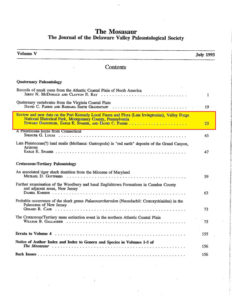
Author Joe Mish has been running wild in New Jersey since childhood when he found ways to escape his mother’s watchful eyes. He continues to trek the swamps, rivers and thickets seeking to share, with the residents and visitors, all of the state’s natural beauty hidden within full view. To read more of his writing and view more of his gorgeous photographs visit Winter Bear Rising, his wordpress blog. Joe’s series “Nature on the Raritan, Hidden in Plain View” runs monthly as part of the LRWP “Voices of the Watershed” series. Writing and photos used with permission from the author.
The Nature Conservancy recently asked the Lower Raritan Watershed Partnership to identify the top issues facing the communities with which we work. We developed our “Top 10” list, below.
A few caveats to this list. First, the Lower Raritan Watershed is comprised of a diversity of communities facing a varied set of issues. Each community would likely identify a different set of priority issues. Second, the LRWP has not conducted a comprehensive survey of need (although it is something we would like to do). The following issues have been identified during discussions with communities, by daily culling of google for Raritan River and watershed-related news stories, reading minutes from Environmental Commission, and from general observation. Many of these issues are inter-related, but we have culled them out as they often seem to be discussed singly.
We very much welcome stakeholder comments, input and suggestions to the add to our list.
- Substandard quality of area waters due to toxic contamination and contamination due to disease-causing pathogens. This bears not only on fishing, swimming and secondary contact, but also on concerns with drinking water quality.
- Uncertainty regarding the quality of area waters: lack of readily accessible (and easily interpreted) information about water quality.
- Linked to, but distinct from the above: the need for restoration of historic contaminated sites and waterways to protect public health.
- Sea level rise, and assistance with preparedness / resiliency planning.
- Flooding, significant impervious surfaces, and disruption of natural / historic hydrologic flows.
- Stormwater runoff and the need for regional stormwater management, including assistance with meeting MS4 requirements from County/state or other regional entity.
- Fragmentation of habitat, including fragmentation of human scale habitat (e.g. walking and bicycling routes).
- Perceptions of safety around riverfront spaces and streams deters use of these spaces (e.g. significant homeless populations, poor lighting, limited access and/or limited signage).
- Aging rail infrastructure that could lead to devastating spills in our waterways.
- Threat of pipelines or other significant infrastructure that might damage habitat.
Article by Dorothy Lee, Rutgers University Sophomore and LRWP Summer Soils Intern
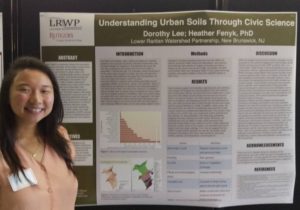
LRWP intern Dorothy Lee, presenting at Rutgers (photo by Heather Fenyk)
This summer I had the opportunity to intern for the LRWP doing soils and civic science research. My job was to conduct initial research into how the LRWP could develop a civic science soil monitoring program to better understand soils functions for an urban watershed level. Urban areas can benefit from soil mapping exercises because urban soils are a concern for food supply, drinking water, stormwater control as well as aesthetics and recreation. Particular issues of urban soils are related to impervious surfaces, erosion, land filling and land leveling, surface removal, contamination, sedimentation and severe compaction. The benefits of working with civic scientists to aid in research means that data can be collected efficiently and in a timely manner while simultaneously connecting the community to their environment.
The LRWP’s specific interests as they relate to soil include soil enrichment for stormwater retention and for bionutrient food availability. After researching these issues, I worked with LRWP President Heather Fenyk and Professor Stephanie Murphy, Director of the Rutgers Soil Testing Lab, to identify ways that the LRWP could begin to engage the Lower Raritan Watershed community in soils research. A few of the actions we thought could orient conversation for future soil-health-oriented civic science studies include: having area civic scientists work to identify “new” bacterial phyla, linking soil health improvement goals to impervious cover remediation actions planned at the municipal level, and evaluating rain gardens as a management strategy to increase soil C, optimize soil N cycling processes, and reduce leaching and gaseous emission losses of nitrogen.
The LRWP is also beginning to develop a plan to communicate the benefits of composting for soil enrichment. This relates directly to my work at Rutgers with a new club, RU Compost. Compost is an efficient way to reduce our food waste, cycle nutrients back into our soils, and create more awareness and education opportunities to the public. At Rutgers our club is working to implement composting in our dining halls and students centers, and we are also working on building a compost demonstration for the Spring semester in the Lower Raritan Watershed. Look for us in the spring!





